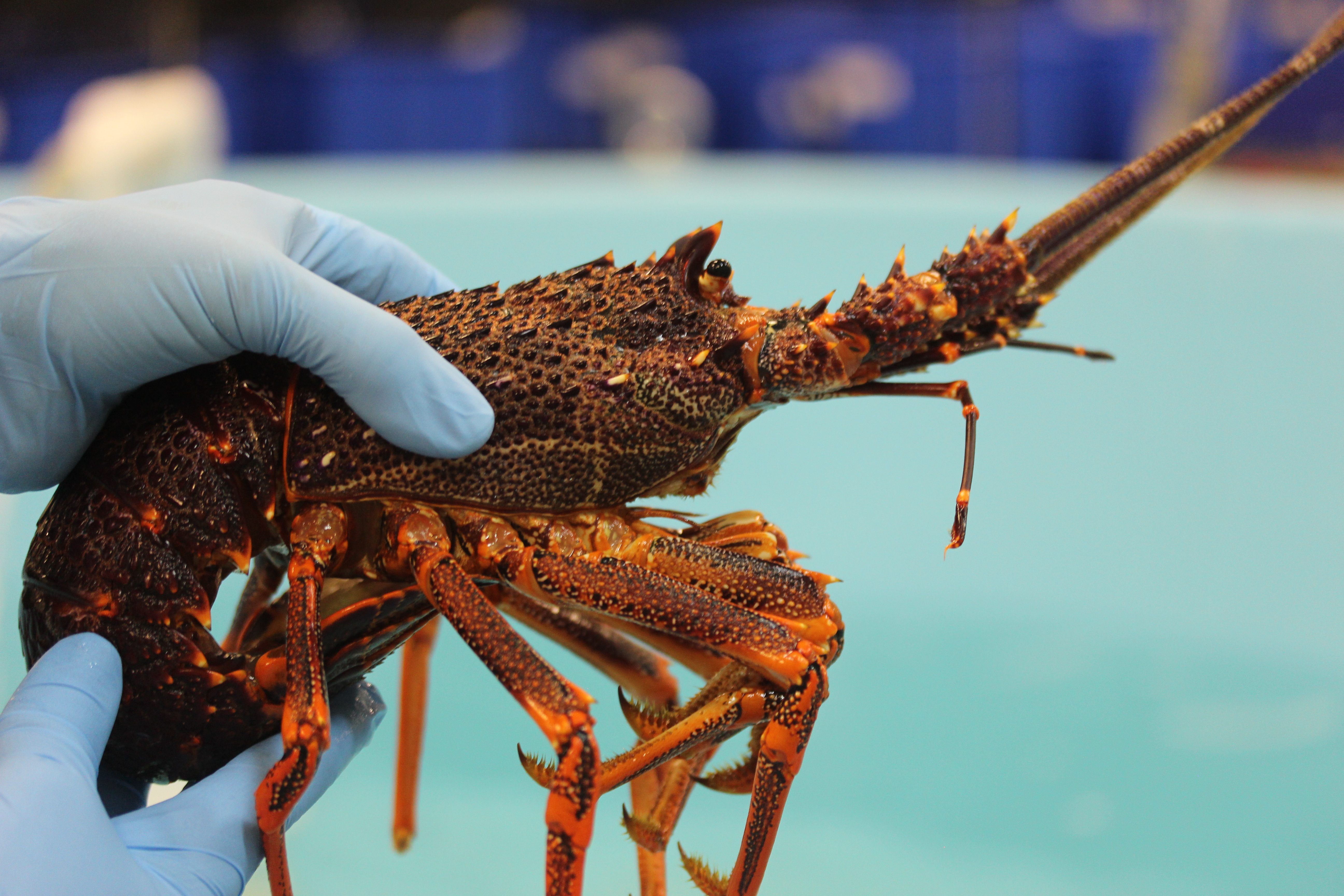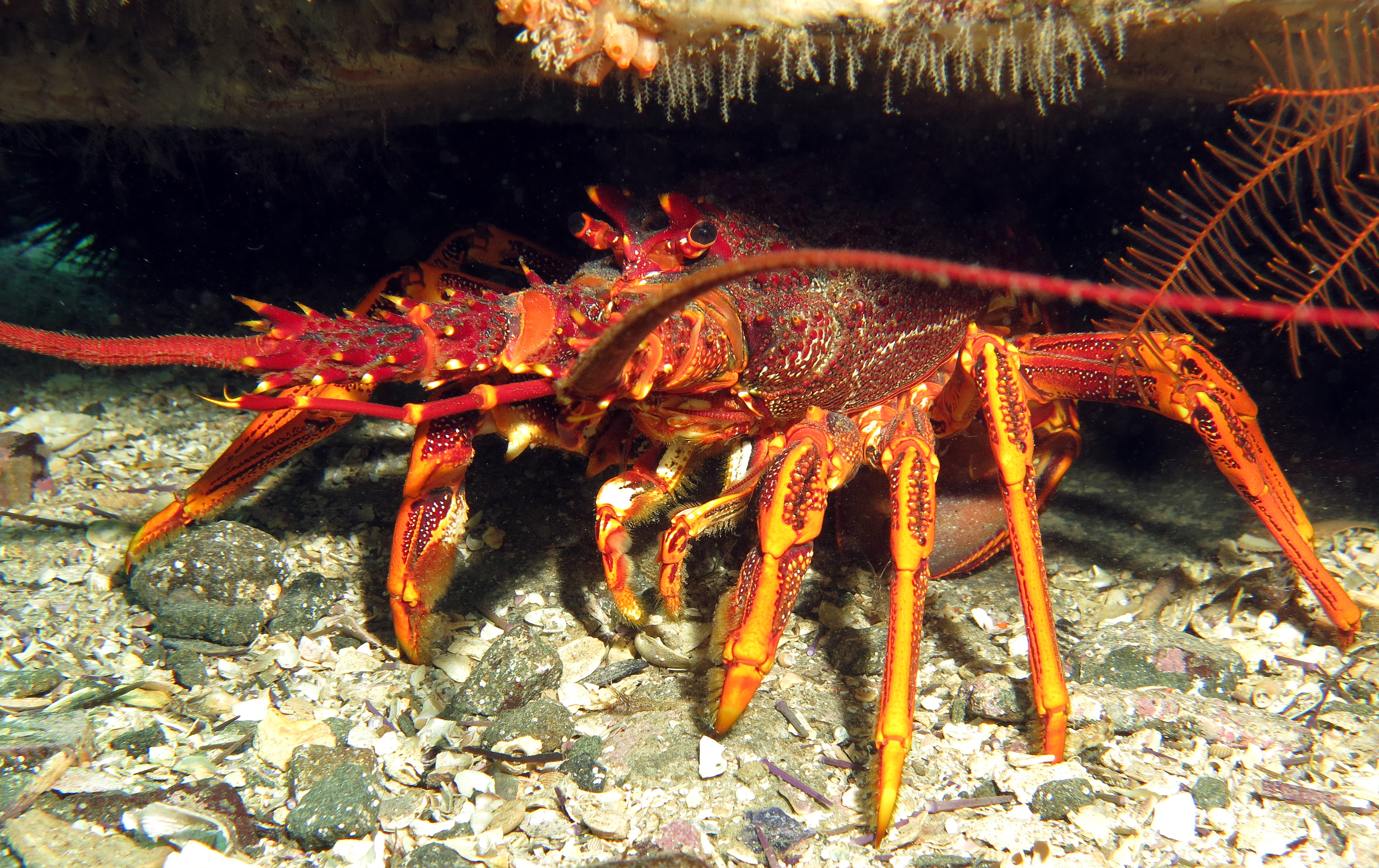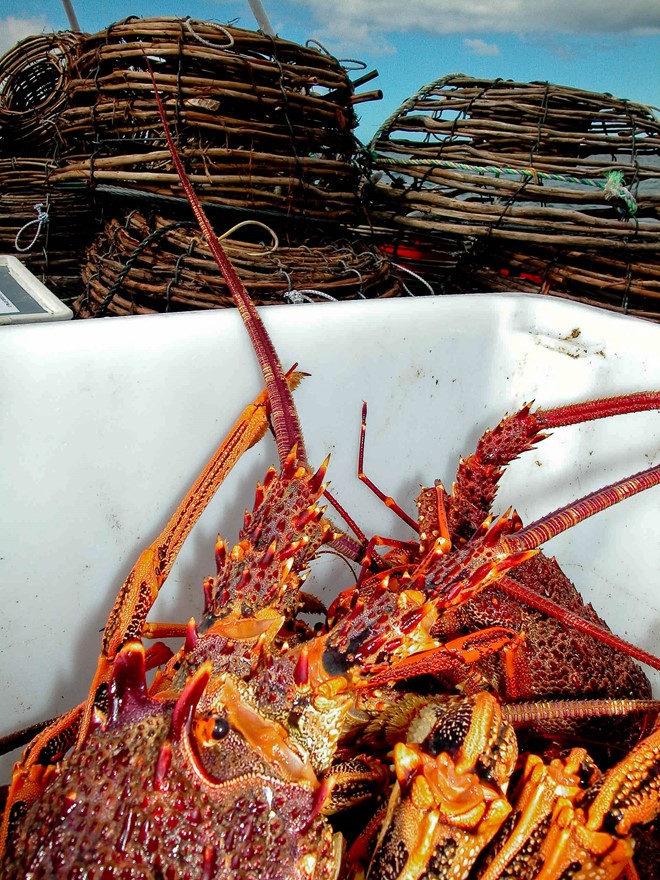
IMAS researchers are helping improve marine biotoxin risk management practices to better protect Tasmania’s Southern Rock Lobster fishery from the impacts of paralytic shellfish toxins (PSTs) produced by harmful algae blooms.
A new IMAS report has shown how rock lobster accumulate PSTs through the consumption of PST-contaminated shellfish. These biotoxins cause human illness if consumed, so ongoing monitoring of all at-risk seafood species ensures store-bought seafood is safe to consume. Risk management includes fishery closures during harmful algae blooms, particularly during years with dense and widespread bloom events.
The research team at IMAS analysed novel monitoring and management techniques to reduce the duration of fishery closures but still protect human health and trade. The work is currently informing how fishery managers address public health and market access risks, and assessed whether these biotoxins could adversely affect lobster health and catchability.
 “We have improved understandings of PST accumulation and purging rates, variability between lobsters, the resilience of adult lobster to biotoxins, and supply chain risks,” said lead author and algae bloom expert, IMAS Emeritus Professor Gustaaf Hallegraeff.
“We have improved understandings of PST accumulation and purging rates, variability between lobsters, the resilience of adult lobster to biotoxins, and supply chain risks,” said lead author and algae bloom expert, IMAS Emeritus Professor Gustaaf Hallegraeff.
“Importantly, we’ve also validated more cost-effective field monitoring using rapid test kits to detect PSTs in the lobster hepatopancreas – the digestive organ – that are above the maximum regulatory level for safe human consumption.
“We found that rapid test kits can facilitate monitoring programs by making faster decisions when PST levels are less than half the regulatory limit.”
IMAS researcher Dr Andreas Seger (pictured right) coordinated test kit validation during the project and said these PST rapid test kits, like COVID antigen tests, show either a positive or negative result. “This gives us an indication within 20 minutes of whether there are elevated toxin levels in the lobster,” Dr Seger said.
“It means negative test results won’t need to b e followed up with comprehensive and costly laboratory analyses, representing significant cost savings for routine biotoxin monitoring and faster sample turnaround.
e followed up with comprehensive and costly laboratory analyses, representing significant cost savings for routine biotoxin monitoring and faster sample turnaround.
“This translates to shorter fishery closures during testing, with fisheries able to re-open if low levels or no PSTs are detected. If the test is positive, additional laboratory testing will be needed to determine exact PST levels and what sort of management action is required.”
Our research team also made some other key findings through this project.
“Another cost-effective strategy we discovered was that mussels represent a reliable sentinel species that serve as an early warning system to identify PST risk areas,” said IMAS researcher Dr Alison Turnbull, Program Leader for Fish Health, Biosecurity and Seafood Safety. “Mussel sentinel lines are now in place along the east coast of Tasmania from June to January and are particularly useful in the high-risk zones of the central east coast.”
Researchers also explored lobster feeding patterns. “Lobsters continue feeding during blooms, resulting in the accumulation of high PST concentrations,” Dr Turnbull said. “Therefore, we suggest frequent biotoxin monitoring at the start of a bloom to monitor lobster PST levels.
“While lobsters can become toxic within days, we also found that lobsters purge PSTs relatively quickly. So sampling to confirm whether lobsters are safe to consume and therefore allowing the fishery to re-open should also occur soon after a bloom collapses.”

A guide on how to dissect rock lobster and access the hepatopancreas for PST testing
Finally, the team also confirmed which situations lobsters become toxic. “Lobsters can only become toxic by eating PST-contaminated mussels and other prey, not by ingesting harmful algae or if algal-contaminated seawater passes over their gills,” Dr Turnbull said.
 “Because of this, we found that adult lobsters don’t appear to experience negative health effects of PSTs, or accumulate PSTs during wet storage on vessels, in sea cages or at processing facilities if harmful algae cells are in the water. It means their survival, quality and safety aren’t impacted in these situations.”
“Because of this, we found that adult lobsters don’t appear to experience negative health effects of PSTs, or accumulate PSTs during wet storage on vessels, in sea cages or at processing facilities if harmful algae cells are in the water. It means their survival, quality and safety aren’t impacted in these situations.”
Dr Turnbull said all these findings are collectively helping improve PST risk management in the Tasmanian Southern Rock Lobster fishery.
This project was supported by funding from the Fisheries Research and Development Corporation on behalf of the Australian Government, Southern Rock Lobster Limited, and the New Zealand Rock Lobster Industry Council. The South Australian Research and Development Institute, NRE Tasmania and the University of Tasmania provided in-kind support.
FAST FACTS – HARMFUL ALGAE BLOOMS
Phytoplankton (microscopic algae) are important to marine ecosystems as they provide energy to food webs. These microalgae can congregate in high densities, known as a bloom, when stimulated by suitable environmental conditions related to temperature, nutrients and water column stratification.
While most blooms aren’t a concern, harmful algae blooms can produce marine biotoxins that can cause paralytic, amnesic or diarrhetic shellfish poisoning if humans consume (in high enough quantities) seafood species that have eaten the toxic algae – leading to illness and (rarely) death.
Species that may eat the toxic algae include bivalve (filter-feeding) shellfish, like oysters, mussels and scallops, leading to biotoxin accumulation in their tissues. Lobster can only become contaminated by eating affected shellfish or other toxic prey.
 Marine biotoxins can cause serious economic and reputational issues in seafood markets due to harvest and export closures. This requires diligent risk management, including measuring biotoxins in seafood, with over $1 million spent on monitoring in Tasmania each year. Biotoxin risk is actively monitored and managed across all at-risk seafood species, meaning store-bought seafood is safe to consume.
Marine biotoxins can cause serious economic and reputational issues in seafood markets due to harvest and export closures. This requires diligent risk management, including measuring biotoxins in seafood, with over $1 million spent on monitoring in Tasmania each year. Biotoxin risk is actively monitored and managed across all at-risk seafood species, meaning store-bought seafood is safe to consume.
Harmful algae blooms regularly form in Tasmania’s coastal waters – the most notable being the extensive ‘Alexandrium catenella’ bloom on the east coast in 2012. This bloom caused the first closure of an Australian lobster fishery due to marine biotoxins, with recurring events having an ongoing impact on commercial and recreational lobster fisheries.
OTHER IMAS PST RESEARCH
Statewide risk management approach
Our researchers are also assessing options for a statewide, integrated approach to harmful algae bloom and marine biotoxin risk management.
The project involves examining the socio-economic impacts of these blooms and biotoxins and associated risk management during low, medium and high-impact bloom years. This study includes commercial and recreational species that can accumulate biotoxins, including oysters, mussels, scallops, pipis, lobster, abalone, and potentially periwinkles and urchins.
Results from this project, which is in partnership with the Department of Natural Resources and Environment Tasmania (NRE Tasmania) and the Tasmanian seafood industry will be released in the not-too-distant future.
Rapid test kits and PSTs in other species
Rapid test kits have previously proven successful for PST tests on farmed mussels and oysters, with many growing areas on the east coast adopting their use during high-risk bloom seasons. These tests supplement the routine regulatory monitoring normally conducted using liquid chromatography, which takes up to 48 hours to analyse.
IMAS is also currently finalising a successful validation of these test kits for use in abalone foot tissues during east coast Alexandrium catenella blooms and assessing the risk of PST uptake in Short and Longspined Sea Urchins and Periwinkles. Outcomes from this research are directly assisting these fisheries with proactive PST risk management.
Further research is currently underway at IMAS to improve our understanding of PST uptake in abalone and any potential impacts that PST might have on abalone health. In the past, we’ve shown that PST uptake does occur in Blacklip Abalone from direct exposure to algal cells and biotoxin consumption. Biotoxin uptake and purging rates in abalone operate on considerably different time scales to lobsters, so require different risk management.
Images:
Published 29 August 2023